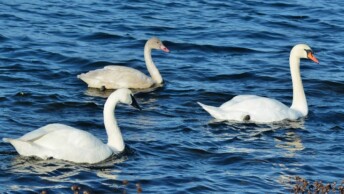Towhees are large, long-tailed sparrows belonging to the family Passerellidae, the diverse group of New World sparrows and buntings. They are placed in the genera Pipilo and Melozone, and are well known for their heavy bills, ground-dwelling habits, and vigorous scratching for food in leaf litter.
There are currently eight recognized living species of towhees, six of which occur in the United States, ranging from the widespread eastern and spotted towhees to the more localized canyon, California, Abert’s, and green-tailed towhees. The remaining two, the collared and white-throated towhees, are Mexican endemics confined to highland forests and scrub.
Towhee taxonomy has long been debated, particularly within the “rufous-sided” towhee complex that historically treated eastern and spotted towhees as one species, and the “brown towhee” complex that includes canyon, California, and Abert’s. Frequent hybridization between some species, especially where ranges overlap, further complicates their classification and highlights their close evolutionary ties.
Eastern Towhee
Pipilo erythrophthalmus
- Identification: Large, long-tailed ground-sparrow; males jet black above with rufous sides, white belly, and flashing white tail corners; females are the same pattern in rich brown; thick blackish bill.
- Where found: Breeds across the eastern United States into southern Canada; winters from the Mid-Atlantic and lower Midwest south through the Southeast and eastern Texas; favors brushy edges, old fields, and dense thickets.
- How to spot: Listen for sharp “chewink” call and a “drink-your-teeeee” song; watch for two-footed backward scratching in leaf litter and white corners flashing in the tail during short, low flights.
- Conservation status: Least Concern; in the U.S. and Canada the species has declined substantially over recent decades, pressured by habitat changes and brood parasitism by brown-headed cowbirds.

The eastern towhee is the quintessential bird of eastern thickets – common, noisy in the undergrowth, and instantly memorable once seen well. It measures 17 to 21 centimeters (6.7 to 8.3 inches) in length, with a long, rounded tail that shows bold white corners in flight and a stout, conical blackish bill for cracking seeds. Males and females are strongly dichromatic, which helps with quick field identification.
Adults are cleanly patterned and unspotted. Males show a black hood, back, wings, and tail set against a white belly and warm rufous flanks; females replace the black with “dead-leaf” brown but keep the same crisp layout. Wing edges may show a small white patch on the folded primaries, and the tail corners are bright white. Iris color varies geographically – often red in northern and mid-Gulf birds and pale straw in much of the Southeast. Juveniles are cinnamon-brown and heavily streaked above and below, quickly transitioning toward the plain adult look.
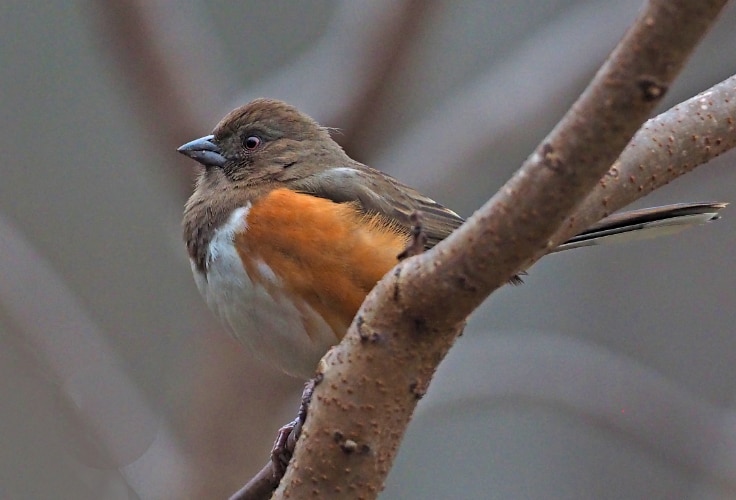
In the field, start with behavior. Towhees hop in leaf litter, then rake backward with both feet to expose seeds and invertebrates, often announcing themselves before you see them. The alarm/contact note is the sharp “chewink/tow-hee” (regional variants occur), and males deliver a clear “drink-your-teeeee” song from low, exposed perches. Flight is short and low through cover; when disturbed they flick and fan the tail, flashing those white corners. Diet is mixed and seasonal, combining seeds, fruits, and a wide range of insects and other invertebrates.
This species breeds widely across the eastern United States into southern Canada, from the central Great Plains east to New England and the Maritimes’ fringe, and south through the Midwest and Southeast to peninsular Florida. Many northern birds migrate to winter in the Southeast and along the Gulf and Atlantic coastal plain, with smaller numbers lingering around feeders and sheltered thickets in the lower Great Lakes and Mid-Atlantic. Habitats are shrub-rich edges, second-growth woods, old fields, and burned or storm-opened forests with a deep litter layer. Nests are most often on or near the ground at the base of shrubs, vines, or briars, sometimes up to about 1.5 meters (4.9 feet) high.
Numbers rose mid-century as farms abandoned to shrubland matured, but have since declined with suburban development, forest regrowth that closes understory, and frequent brood parasitism by brown-headed cowbirds. Long-term surveys indicate sustained, accelerating declines across much of the range. Conservation actions that maintain early- to mid-successional shrub habitats, protect brushy edges, and manage human disturbance around nesting areas can benefit local populations; winter survival improves where dense cover and natural food or feeders are available.
Spotted Towhee
Pipilo maculatus
- Identification: Large, long-tailed ground-sparrow; males black above with crisp white spots on wings and back, rufous flanks, white belly, and white tail corners; females similar but browner or grayish; thick blackish bill and red eye.
- Where found: Widespread in western North America from southern Canada through the western United States into Mexico and Guatemala; uses dry thickets, chaparral, shrublands, and forest edges with dense understory.
- How to spot: Listen for a buzzy trill song and catlike “mew” call; watch for two-footed backward scratching in leaf litter and for bold white spotting on the upperparts compared with eastern towhee.
- Conservation status: Least Concern; broadly stable, with local pressures from habitat loss, outdoor cats, and small-island subspecies affected by overgrazing or brush removal.

The spotted towhee is the characteristic towhee of sunlit western thickets – striking, vocal, and often first detected by sound rather than sight. It measures 17 to 21 centimeters (6.7 to 8.3 inches) in length, with a moderately long, rounded tail that flashes white in the corners and a stout, conical bill suited to seeds and hard-shelled prey. Compared with eastern towhee, it is notable for its bold white spotting and wing bars.
Adults are cleanly patterned but variably dark above. Males range from jet black to slaty or dusky brown on hood, back, wings, and tail; females show the same layout in softer brown or gray. Both sexes have a white belly, bright rufous sides, and a cinnamon crissum, with white spots on the scapulars and coverts forming two wing bars; tail corners are white. Eye color is red in typical northern populations. Juveniles are yellowish to buffy-brown and heavily streaked above and below for only a few weeks before molting toward the adult pattern.
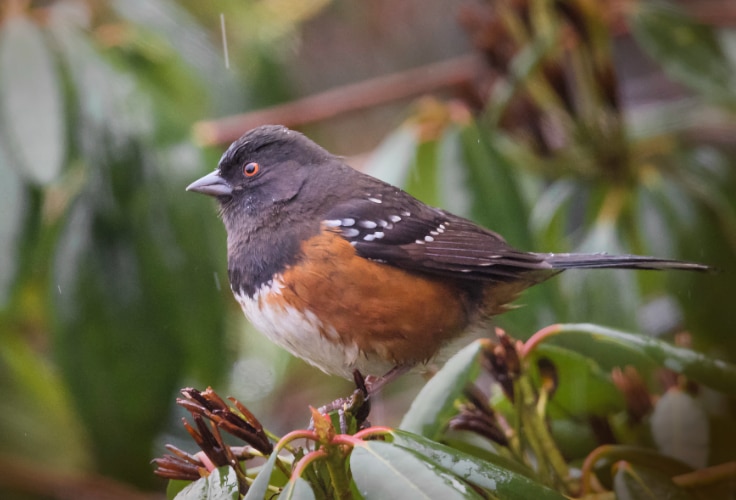
Field identification starts with behavior and voice. Spotted towhees rummage methodically on the ground and use a distinctive two-footed, backward “double-scratch” to flip leaf litter, then pounce on exposed food. Disturbed birds flick wings and fan the tail, flashing white corners. The common call is a nasal, catlike “mew,” and males deliver a short song built from an introductory note into a buzzy trill; trill pace and structure vary geographically. Diet is mixed and seasonal, combining beetles, true bugs, caterpillars, crickets and other arthropods with small seeds, acorns, and fruits; some arboreal foraging peaks in spring.
Across North America it breeds from southern British Columbia, Alberta, and Saskatchewan south through the Pacific states, Great Basin, and interior West to the southern Rockies and into northwestern Mexico; farther south it occupies Mexican highlands to southwestern Guatemala. Many coastal Pacific Northwest birds are resident, while interior and northern Great Basin and northern Rockies populations migrate or shift downslope for winter, extending east to the central Plains and south into northern Mexico. Typical habitats are chaparral, sagebrush and shrub-steppe edges, riparian thickets, and brushy canyon slopes with a deep litter layer and overhead screening. Nests are placed on the ground or low above it near shrubs, grasses, logs, or vine tangles, often at patch edges.
The species is widespread and generally stable, benefiting in places from early-successional shrub cover created by disturbance, yet vulnerable where brush is cleared, understories are shaded out, or outdoor cats are common. Island and peninsular forms can be sensitive to overgrazing and habitat loss. Maintaining brushy mosaics, protecting chaparral and riparian thickets, and managing predators near nesting areas support local populations, while wintering birds persist where dense cover and natural seed sources remain.
Green-Tailed Towhee
Pipilo chlorurus
- Identification: Large, long-tailed ground-sparrow with gray body, olive-green upperparts and tail, crisp white throat and supraloral spots, and a conspicuous rufous crown; sexes similar, females slightly duller.
- Where found: Breeds in montane shrublands of the interior West into northern Baja California; winters at lower elevations from the Southwest and Texas south through much of Mexico; favors post-fire or post-logging regrowth, sagebrush, and open pinyon-juniper.
- How to spot: Listen for a clear, whistled song that ends in a raspy trill and a nasal “mew;” watch for two-footed backward “double-scratch” in leaf litter and low, bounding flights into dense shrubs.
- Conservation status: Least Concern; overall trends broadly stable, with local pressures from sagebrush shrubsteppe degradation and brush removal.

The green-tailed towhee is the western towhee of high, sunlit shrublands – unmistakable once seen well. About 18 centimeters (7.1 inches) long, it shows a long greenish tail, olive-green wings and back, a clean gray breast, and a bright rufous crown set off by white throat and supraloral spots. The bill is stout and conical, built for seeds. Among North American towhees, it is notable for its combination of gray underparts and green upperparts.
Adults are essentially monochromatic between sexes, though females can look slightly duller, especially on the crown. The pattern is crisp: gray head and breast contrasting with the white throat and spots in front of the eye, olive upperparts, rufous cap, and green tail. Juveniles lack the adult contrasts, appearing brownish-gray above and whitish below with heavy streaking and two faint olive wing bars; their eyes are browner, turning warmer reddish in adults.

In the field, focus on behavior and voice. Birds forage low, hopping deliberately and using a two-footed backward “double-scratch” to flip leaf litter, then pecking seeds, small fruits, and insects; they also glean low foliage in spring. Typical calls include a nasal, ascending “mew,” sharp “tick” alarms, and a thin, drawn-out “tseee.” The song is a series of clear whistled notes, often preceded by a drawn-out phrase and ending in a raspy trill. Flights are usually low and direct between shrubs, with brief bounding and tail pumps before dropping back into cover.
Breeding spans mid- to high-elevation shrublands across the interior West, from the Blue Mountains and Cascades east and south through Idaho, Montana, Wyoming, Nevada, Utah, Colorado, Arizona, and New Mexico, into California’s Sierra Nevada and Transverse/Peninsular ranges, and locally in northern Baja California. Habitat is dry, open shrublands with a litter layer, especially sagebrush ecotones, serviceberry thickets, and open pinyon-juniper with dense understory, often thriving in post-fire regrowth. Nests are well concealed within shrubs, canes, or small firs. This towhee is a short- to medium-distance migrant. Many birds shift downslope after breeding to winter in the Southwest and Texas, with broad movement into Mexico.
Abundance is generally stable at the continental scale, but local declines occur where sagebrush systems are degraded by grazing, invasive plants, and altered fire regimes. Conservation that maintains shrub mosaics, especially natural post-fire succession and structurally diverse pinyon-juniper, supports populations. The species also uses regrowth created by careful forest management.
California Towhee
Melozone crissalis
- Identification: Large, stocky, long-tailed ground-sparrow, plain gray-brown overall with rusty tones on face, faint dusky markings on throat, and rich cinnamon undertail coverts; sexes alike.
- Where found: Resident from southern Oregon through California into Baja California, in chaparral, scrub, riparian thickets, and suburban gardens.
- How to spot: Look for a plain brown towhee scratching noisily under shrubs or running across open ground; listen for metallic “chink” calls and accelerating series of notes like a bouncing ball.
- Conservation status: Least Concern; overall populations stable, though an isolated subspecies in the Inyo Mountains is federally threatened due to severe habitat loss.
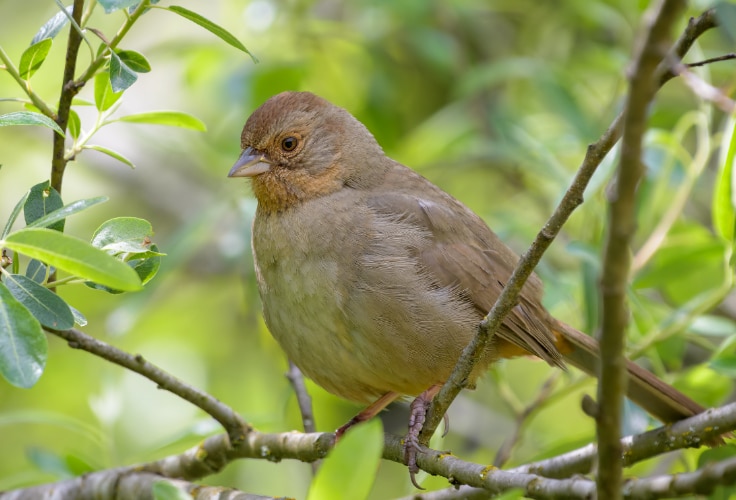
The California towhee is the familiar towhee of chaparral and gardens across much of California. Measuring 21 to 25 centimeters (8.3 to 9.8 inches) in length, it is one of the largest sparrows in North America, stocky with a long tail and heavy bill. Its plainer plumage sets it apart from spotted or rufous-sided relatives, yet its ubiquity in backyards makes it one of the most frequently seen towhees in the region.
Adults are largely matte gray-brown, with a slightly darker crown and wings, rusty wash on the face, and warm cinnamon undertail coverts. The throat is pale with faint dusky borders, and the breast may show light streaking but lacks a distinct central spot. The eye is orange-brown and the bill dark with a paler base. Juveniles appear paler and more uniform, sometimes showing faint wing bars and lacking the adults’ cinnamon tones. Males and females look alike.
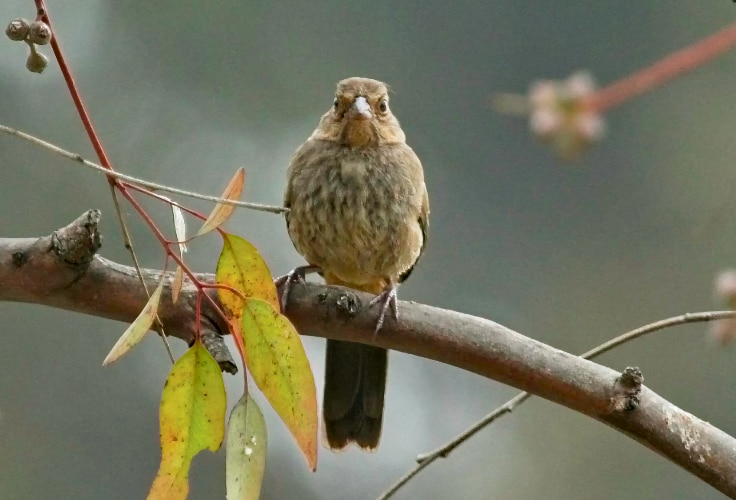
In the field, California towhees are often detected by their metallic “chink” calls or duet-like squeals between pairs. They spend much of their time on the ground, hopping or running between cover, and foraging with the vigorous two-footed “double-scratch” typical of towhees. Their song is an accelerating series of chip notes, likened to the rhythm of a bouncing ball, and they may sing persistently before pairing. The diet is primarily seeds and fruits, supplemented by insects, especially when feeding young.
The species’ range extends from extreme southern Oregon south through nearly all of California and into the length of Baja California. It inhabits chaparral, coastal sage scrub, oak woodlands, riparian thickets, and brushy canyons, as well as suburban yards and parks where native vegetation is retained. Nests are typically placed in dense shrubs or low trees, often in edge habitats with a mix of cover and open ground.
California towhees are abundant and secure across most of their range, with populations stable over recent decades. They adapt readily to human-altered environments such as gardens, farms, and suburban edges, though they remain absent from highly urbanized centers. Local declines occur where chaparral and riparian habitats are lost to development or overgrazing, and the isolated Inyo Mountains subspecies faces severe threats. Overall, the species remains a widespread and resilient member of western bird communities.
Canyon Towhee
Melozone fusca
- Identification: Large, long-tailed ground-sparrow with plain brown body, rufous crown, buffy throat bordered below by dusky markings, a faint central chest spot, and warm buff undertail coverts; sexes alike.
- Where found: Permanent resident of the southwestern United States and Mexico, from Arizona, New Mexico, Colorado, and Texas south through the Sierra Madre ranges into west-central Mexico; favors deserts, arid grasslands, and foothill scrub.
- How to spot: Look for a plain brown towhee with a reddish crown running or hopping on the ground; listen for a variable tinkling song of even syllables and rough “shedup” or high “seep” calls.
- Conservation status: Least Concern; overall populations stable though locally declining with suburban development, exotic vegetation, and predation by cats.

The canyon towhee is the plainest of the towhees, blending into desert and foothill landscapes yet standing out by its size and crown color. At 21 to 25 centimeters (8.3 to 9.8 inches) in length, it is one of the largest North American towhees. Its stocky frame, long tail, and earthy brown plumage match its arid habitats, but the rufous crown and buffy undertail coverts provide useful field marks.
Adults are uniform brown with slightly warmer tones above, a pale throat bordered below by darker streaks, a subdued central chest spot, and buffy-orange undertail. The crown shows a reddish wash that can be bright in fresh plumage. Both sexes look alike, and juveniles resemble adults but may show duller tones. This simplicity of plumage makes the species more subtle than spotted or eastern towhee, but the reddish crown and plain brown face separate it from the similar California towhee.
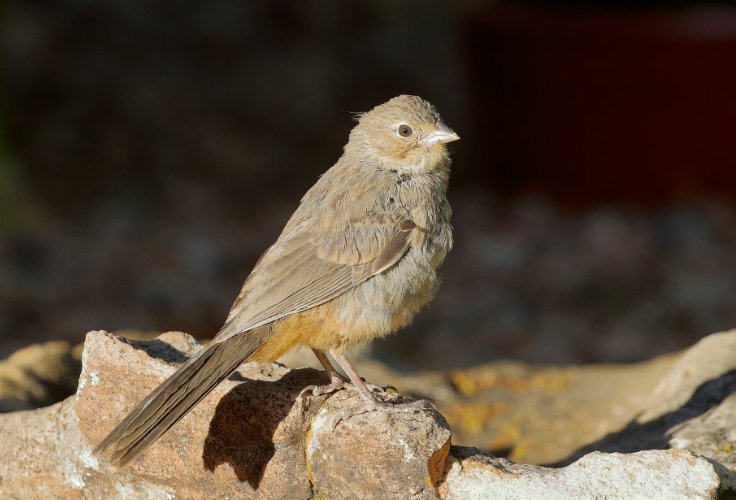
In the field, canyon towhees stay close to the ground, often running rather than flying. Their flight is short, slow, and maneuverable, usually just a few meters into shrubs. On the ground they hop or run, sometimes using the characteristic two-footed backward “double-scratch,” though less noisily than other towhees. They forage alone or in pairs, taking mostly seeds along with insects, berries, and occasional invertebrates. Calls include rough “shedup” notes, high “seep” alarms, and a variety of squeals and chatters between mates. Males sing a tinkling, repetitive series of even syllables, often from exposed perches during the breeding season.
The range extends from the southwestern United States south through much of Mexico. In the U.S., it occupies Arizona, New Mexico, southeastern Colorado, northwestern Oklahoma, and central and western Texas. It inhabits desert grasslands, arid foothills with mesquite and catclaw, pinyon-juniper and pine-oak uplands, and drier riparian edges. Nests are placed in shrubs, small trees, or dense cover, and the species may raise two broods in response to summer and winter rains. Unlike Abert’s towhee, it favors open or edge habitats rather than closed riparian groves.
Populations are generally stable, with some regional declines linked to suburban development and replacement of native vegetation with exotics. Canyon towhees adapt reasonably well to rural edges and agricultural landscapes but avoid dense urban centers. Around human settlements, predation by domestic cats poses a serious risk. Conservation is aided by maintaining native vegetation, especially desert shrubs and riparian thickets, and by limiting habitat degradation from overgrazing or urban sprawl.
Abert’s Towhee
Melozone aberti
- Identification: Large, plain, long-tailed sparrow; gray-brown overall with pinkish bill, dark blackish mask around lores, chin, and malar region, and rich orange undertail coverts.
- Where found: Resident of the Sonoran Desert region, mainly in Arizona, with limited range into California, Nevada, Utah, New Mexico, and northwestern Mexico; favors dense riparian thickets and mesquite.
- How to spot: Look for a secretive brown towhee with a dark face mask foraging on the ground in dense brush; listen for squeal duets between pairs and sharp, high-pitched “peep” notes.
- Conservation status: Least Concern; populations stable or increasing, though historic riparian habitat has been greatly reduced by agriculture, grazing, and development.
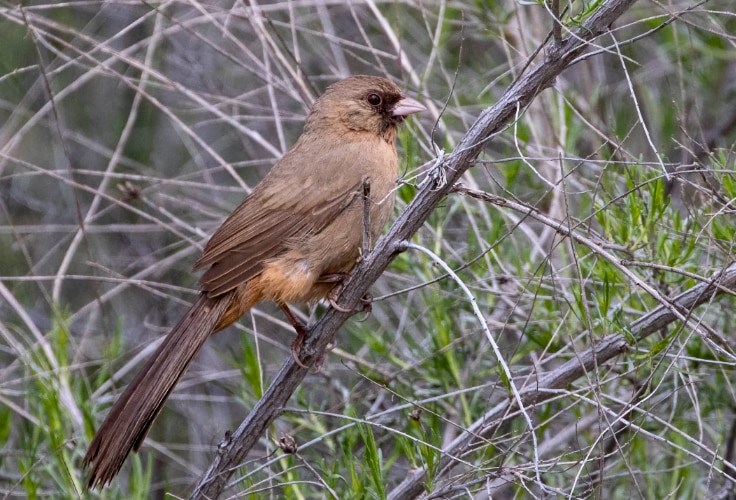
The Abert’s towhee is the characteristic towhee of the Sonoran Desert, tightly bound to riparian corridors. Measuring 21 to 23 centimeters (8.3 to 9.1 inches) in length, it is large for a sparrow, with a long tail and heavy bill. Though drab overall, it is instantly recognizable by its black face mask, pale bill, and rusty undertail. Its restricted range makes it a regional specialty of the American Southwest.
Adults are grayish brown above and below, with little contrast between crown, back, and wings. The face is set off by extensive black on the lores, chin, and malar region, creating a masked look. The undertail coverts are a strong rusty-orange, and the bill is pale horn with a dusky tip. Both sexes are identical, and juveniles resemble adults but are duller. This plain but distinctive plumage helps separate it from canyon and California towhees, which lack the full black mask.

In the field, Abert’s towhees keep low in dense vegetation, foraging mostly on the ground. They employ the characteristic two-footed “double-scratch” in leaf litter, uncovering seeds and insects, and also glean prey from bark or low shrubs. They are secretive yet can be bold at feeders or water sources, sometimes displacing other sparrows and cardinals. Vocalizations are relatively simple but conspicuous: pairs give loud squeal duets daily to reinforce their lifelong bonds, while males utter sharp “peep” songs to advertise territories.
The species’ range is confined to the Sonoran Desert and its riparian corridors. Strongholds are along the Gila and lower Colorado rivers in Arizona, with smaller populations in adjacent California, Nevada, Utah, and New Mexico, and across the border into northwestern Mexico. It inhabits cottonwood-willow and mesquite woodlands with dense understory, as well as tamarisk thickets and suburban areas with native vegetation. Nests are usually placed low in dense brush or quailbush.
This towhee remains fairly common within its limited distribution, with populations showing modest increases in recent decades. Historically, however, numbers were much higher before extensive loss of riparian habitat – an estimated 95% reduction due to agriculture, grazing, and urban development. Today the species benefits from suburban plantings and from habitat restoration projects aimed at other riparian birds such as the southwestern willow flycatcher. While locally secure, long-term conservation depends on maintaining and restoring riparian corridors throughout the desert Southwest.
White-Throated Towhee
Melozone albicollis
- Identification: Large, long-tailed sparrow with brown upperparts, narrow pale wingbars, white throat bordered by a rusty-cinnamon band, gray sides, and reddish iris; sexes similar.
- Where found: Endemic to southern Mexico, mainly Oaxaca with smaller populations in Guerrero and Puebla; favors semi-arid shrublands and pine-oak forests.
- How to spot: Look for a plain brown towhee with a crisp white throat and rusty breast band, often in small noisy groups scratching on open, brushy slopes.
- Conservation status: Least Concern; locally common within its restricted Mexican range, though habitat alteration remains a potential threat.

The white-throated towhee is a Mexican endemic and a characteristic sparrow of the highlands of Oaxaca. Measuring 18 to 22 centimeters (7.1 to 8.7 inches) in length, it is a medium-to-large towhee with a long tail and stout bill. It is notable for its restricted distribution, as well as its distinctive white throat patch, which sets it apart from other brown towhees of the region.
Adults are brown overall with a slightly warmer crown and nape, narrow pale wingbars, and a white supercilium. The throat and upper chest are white, bordered by a rich cinnamon band that extends across the lower throat and into the flanks. The breast sides are gray, the belly whitish with gray mottling, and the undertail coverts cinnamon. The iris is reddish and the bill dark above and paler below. Juveniles resemble adults but are duller and more mottled across the chest, with cinnamon-tinged wingbars.

In the field, white-throated towhees are usually encountered on the ground or in low shrubs, foraging with vigorous scratching similar to other towhees. They often occur in pairs or small flocks of up to a dozen birds, moving noisily through semi-open scrub or pine-oak understory. Their song is a series of sharp chipping notes followed by a trill, while the call is a distinctive metallic, slurred “churenk.” The diet is primarily seeds, supplemented by insects and fruit.
This towhee’s range is restricted to the highlands of southern Mexico, with core populations in Oaxaca and smaller groups in adjacent Guerrero and Puebla. It inhabits dry montane shrublands, broken slopes, and pine-oak woodlands at mid to high elevations. Nests are bulky grass cups placed on or near the ground, often concealed beneath dense shrubs, with clutches of four pale blue to whitish, brown-spotted eggs.
The species is fairly common and conspicuous within its limited range. However, its reliance on montane shrub and pine-oak habitats makes it potentially vulnerable to land clearing, agricultural expansion, and habitat fragmentation. Continued monitoring in Oaxaca and surrounding states is important to ensure the persistence of this localized yet distinctive towhee.
Collared Towhee
Pipilo ocai
- Identification: Large, long-tailed sparrow with striking head pattern – rufous crown, bold white supercilium, black mask and collar, and white throat; olive-green upperparts and yellow wing bend add contrast.
- Where found: Endemic to the highlands of central and southern Mexico, from Jalisco and Veracruz to Oaxaca and Guerrero, mainly in pine–oak and coniferous forests.
- How to spot: Look for a skulking towhee in dense undergrowth, with a bright white throat cut by a broad black chest band; listen for loud, varied songs of chips and trills and nasal “zhree” calls.
- Conservation status: Least Concern; locally common to very common in suitable habitat; overall stable, though restricted to a limited montane range.

The collared towhee is one of the most striking members of the group, notable for its bold patterning and limited distribution in the Mexican highlands. At 19 to 23 centimeters (7.5 to 9.1 inches) in length, it is a robust towhee with a long tail and heavy bill. Unlike the plain brown California and canyon towhees, this species shows a strongly marked face and breast, making it one of the easiest towhees to recognize.
Adults combine a rufous crown with a long white eyebrow and black mask, lores, and ear coverts. The throat is bright white, bordered by a broad black chest band that gives the bird its name. The upperparts and tail are olive-green, and the bend of the wing shows a distinctive yellow patch. Underparts are pale gray on the breast and whitish centrally, with cinnamon flanks and undertail coverts. Juveniles are duller, with streaked brown upperparts and less sharply defined facial and breast markings. Several subspecies differ subtly in plumage, with some showing darker faces or narrower chest bands.
In the field, collared towhees are more often heard than seen, skulking low in brush or dense understory. They forage mainly on the ground, scratching among leaf litter for seeds, fruit, and small invertebrates. They are usually found singly, in pairs, or in family groups, but may join loose mixed flocks. The song is varied and loud, a sequence of chips, whistles, and trills, while the call is a nasal “zhree” or “jor-ee.”
The species is confined to montane regions of central and southern Mexico, with populations in Jalisco, Colima, Michoacan, Guerrero, Oaxaca, Puebla, and Veracruz. It inhabits the understory of pine-oak and pine-evergreen forests, as well as shrubby edges, brushy fencerows, and overgrown clearings, usually between 1,500 and 3,500 meters (5,000-11,500 feet). Nests are bulky cups placed low in shrubs, often containing clutches of four bluish, dark-spotted eggs.
Although restricted in distribution, the collared towhee remains common in much of its range and is considered secure. Its dependence on montane shrub and forest understory, however, may make it vulnerable to deforestation, agricultural clearing, and habitat fragmentation. Protecting Mexico’s pine-oak forests ensures the continued abundance of this distinctive towhee.
Closing Notes on the Towhee Family
Towhees bring together the qualities of both the familiar and the unique. Across much of the U.S., the sharp calls and rustling leaf-litter of eastern or spotted towhees are a regular part of woodland birding, while in the Southwest, California, canyon, and Abert’s towhees lend character to chaparral, deserts, and riparian thickets. Farther south, the collared and white-throated towhees represent distinct Mexican endemics that anchor the group’s diversity.
Their story is also one of scientific intrigue. From the historic lumping and splitting of the “rufous-sided” and “brown” towhees to the frequent hybridization that blurs boundaries between species, towhees remain a classic case study in avian taxonomy. Together, they show how a single group of sparrows can be both backyard companions and subjects of evolutionary debate, reminding us that even the most common birds have complex histories worth paying attention to.


